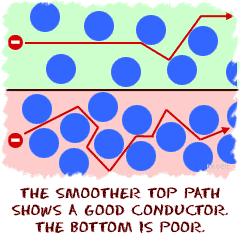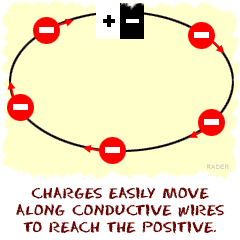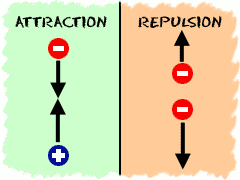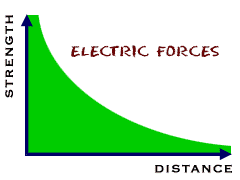Conductors and Conductivity
 There are many materials that allow charges to move easily. They are called conductors. Conductors have the quality of conductivity.
I guess that's not a lot of help for you. The reality is that you just
need to understand the difference between those two words. The conductor
is the object that allows charge to flow. Conductivity is a quality
related to the conductor. A material that is a good conductor gives very
little resistance to the flow of charge. This flow of charge is called an electric current. A good conductor has high conductivity.
There are many materials that allow charges to move easily. They are called conductors. Conductors have the quality of conductivity.
I guess that's not a lot of help for you. The reality is that you just
need to understand the difference between those two words. The conductor
is the object that allows charge to flow. Conductivity is a quality
related to the conductor. A material that is a good conductor gives very
little resistance to the flow of charge. This flow of charge is called an electric current. A good conductor has high conductivity.
Different Types of ELECTRICAL Conductors
Electrical conductors are materials that allow electricity to flow through them easily. Most metals are good conductors.
Electrical insulators are materials that do not allow electricity to flow through them. Most plastic and ceramic materials are insulators.
In the diagram of an electrical insulator, the insulating material (plastic) surrounds the conducting material (copper wires).
(1) Metals are traditional conducting materials. You
see them around the house all of the time. It's a metal wire or one of
the metal prongs in an electric plug. There are a lot of free electrons
in metallic conductors. Free electrons are electrons that are not being
held in atoms, and so, can move easily. - Some of the best metallic conductors are copper (Cu), silver (Ag), and gold (Au).
 (2) There are some conductors that are not metals. Carbon is the best example.
(2) There are some conductors that are not metals. Carbon is the best example.
(3) You've probably seen ionic conductors in a lab or in an experiment. When you think about ionic conductors, think about solutions and molten conductors.
- A solution such as saltwater has a lot of free ions floating around. Those ions (charged atoms) can flow easily, and ionic solutions are very good conductors.
- One of the reasons you need to get out of the water if there is lightning around, is that water normally contains dissolved ions, and if lightning hits the liquid (solution), it might conduct electricity long distances and electrocute you.
(4) Semi-conductors are the conductors that make your computer possible. If it weren't for semi-conductors, most electronic doodads couldn't be made. Semiconductors have free electrons, but not as many as conductors, and they are not as easy to get moving. Semiconductors have low conductivities.
- SEMI CONDUCTORS have both conducting and insulating properties and they are used to make electronic components. The way in which a semi-conducting material is connected to a power supply determines whether it will conduct an electrical current or prevent it from flowing.
- Examples are elements like silicon (Si) and germanium (Ge).
Conductors and Insulators
Conductors are made of materials that electricity can flow through easily.
These materials are made up of atoms whose electrons can move away freely.
These materials are made up of atoms whose electrons can move away freely.
Some examples of conductors are:
|
Insulators are materials opposite of conductors. The atoms are not easily freed and are stable, preventing or blocking the flow of electricity.
Some examples of insulators are:
- Glass
- Porcelain
- Plastic
- Rubber
Electricity will always take the shortest path to the ground. Your body is 60% water and that makes you a good conductor of electricity. If a power line has fallen on a tree and you touch the tree you become the path or conductor to the ground and could get electrocuted.
The rubber or plastic on an electrical cord provides an insulator for the wires. By covering the wires, the electricity cannot go through the rubber and is forced to follow the path on the aluminum or copper wires.

Let Them Move
 So what happens if you have separated charges and you connect them with
conducting material? Providing a path for charges to move, and making
that path out of materials that allow easy movement, results in a flow
of charge (electrons) called a current. The electrons
will flow from a location that is negative to one that is positive.
This can happen quickly and then stop, as with a spark. Or, in the case
of a battery connected to a conducting loop (called a circuit. ), it
continues to happen until the battery runs out of energy.
So what happens if you have separated charges and you connect them with
conducting material? Providing a path for charges to move, and making
that path out of materials that allow easy movement, results in a flow
of charge (electrons) called a current. The electrons
will flow from a location that is negative to one that is positive.
This can happen quickly and then stop, as with a spark. Or, in the case
of a battery connected to a conducting loop (called a circuit. ), it
continues to happen until the battery runs out of energy. - If the current goes in one direction all the time, it is called DC, or direct current.
- In your home, however, the same charges move back and forth, so this is called AC, or alternating current.
Force of Charges
 Scientists discovered that opposite charges attract, and like charges
repel. So positive-positive and negative-negative would repel, while
positive-negative would attract. Physicists use the term electric force
to describe these attractions and repulsions. The electric forces are
much stronger when negative charges are closer to positive charges. The
further apart two charges are, the weaker the electric force. Also, the
greater the charges, the greater the electric force will be.
Scientists discovered that opposite charges attract, and like charges
repel. So positive-positive and negative-negative would repel, while
positive-negative would attract. Physicists use the term electric force
to describe these attractions and repulsions. The electric forces are
much stronger when negative charges are closer to positive charges. The
further apart two charges are, the weaker the electric force. Also, the
greater the charges, the greater the electric force will be.
